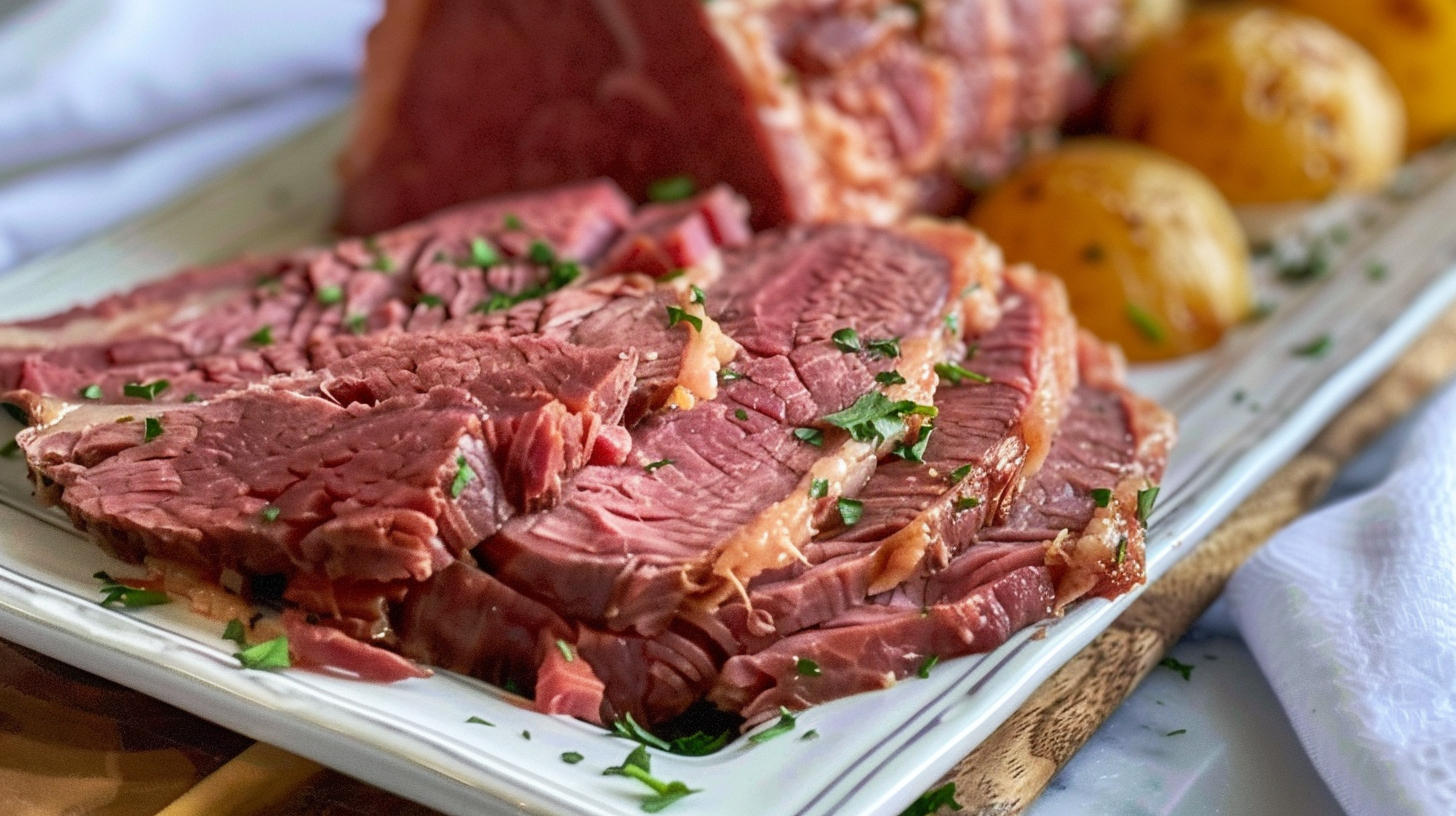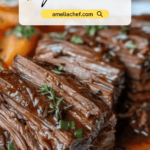Introduction to Beef Chuck Roast
Beef chuck roast is a popular cut of meat prized for its rich flavor and versatility in various culinary traditions. Derived from the shoulder area of the cow, this cut is perfect for slow-cooking methods, which help break down its dense connective tissue, resulting in tender, flavorful dishes. Recipes for beef chuck roast often involve braising, roasting, or slow-cooking in a crockpot, where the meat is cooked at low temperatures for several hours. This cooking process renders the fat and the beef succulently soft and juicy.
Popular Beef Chuck Roast Recipes
Popular recipes for beef chuck roast include classic pot roast, where the meat is cooked with root vegetables and herbs in a rich broth. This dish is a staple in many households due to its simple preparation and comforting taste. Other innovative preparations involve using the chuck roast in beef stews as the base for beef bourguignon or even pulled beef sandwiches, where the cooked meat is shredded and mixed with barbecue sauce. The versatility of beef chuck roast makes it a favorite for family dinners, festive occasions, and easy weeknight meals, offering endless possibilities for those who appreciate its hearty, satisfying flavor.
Classic American Pot Roast: A Standout Beef Chuck Roast
One standout recipe showcasing beef chuck roast’s versatility is the classic American Pot Roast. This dish is exciting for several reasons, including its cultural significance, seasonal relevance, and broad appeal.
Cultural Significance of Pot Roast : Beef Chuck Roast
Pot roast is a quintessential American dish, often associated with family gatherings and Sunday dinners. Its origins can be traced back to the early settlers, who utilized slow-cooking methods to tenderize tougher cuts of meat. This tradition has persisted, making pot roast a comforting staple in American homes, synonymous with warmth and familial care.
Seasonal Relevance of Pot Roast : Beef Chuck Roast
Pot roast is especially popular in the colder months. Its hearty and warming qualities make it ideal for fall and winter when people crave richer, more substantial meals. Cooking a pot roast fills the home with inviting aromas, enhancing the cozy atmosphere that many associate with the chilly season.
Broad Appeal of Pot Roast
The recipe for pot roast often include a variety of vegetables, such as carrots, potatoes, and onions, which are slow-cooked with the meat in a single pot. This method infuses the vegetables with the savory flavors of the beef and makes it a convenient one-pot meal, appealing to those who value simplicity in meal preparation. Additionally, pot roast can easily be adapted to fit various dietary preferences, such as low-carb or gluten-free diets, by simply adjusting the accompanying ingredients.
The combination of cultural tradition, seasonal suitability, and adaptability makes the classic pot roast a beloved recipe for beef chuck roast, worthy of both casual family dinners and more formal festive occasions.
For a classic American Pot Roast, you’ll need the following ingredients: Beef Chuck Roast
- Beef Chuck Roast (about 3-4 pounds)
- Kosher Salt and Freshly Ground Black Pepper (for seasoning)
- Vegetable Oil (2 tablespoons)
- Onions (2 medium, peeled and quartered)
- Carrots (4 large, peeled and cut into chunks)
- Celery Stalks (2, cut into chunks)
- Garlic (4 cloves, minced)
- Beef Broth (2 cups)
- Dry Red Wine (1 cup, optional)
- Worcestershire Sauce (1 tablespoon)
- Bay Leaves (2)
- Fresh Thyme (several sprigs)
- Potatoes (4 medium, peeled and cut into chunks)
Important Notes About Specific Ingredients: Beef Chuck Roast
- Organic Ingredients: If you prefer to use organics ingredients, it’s particularly beneficial for the beef, vegetables, and broth to be organic to avoid pesticides and to enhance the flavor of your dish.
- Substitutions for Common Allergens:
- Wine: If you need to avoid alcohol, substitute the red wine with additional beef broth or use non-alcoholic wine.
- Beef Broth: For a gluten-free alternative, ensure the beef broth is certified gluten-free, as some brands may contain gluten.
- Vegetable Oil: If you are allergic to soy or other ingredients commonly found in vegetable oils, you can use olive or another suitable oil.
These substitutions and considerations will help ensure that your pot roast meets your dietary needs while delivering a delicious, comforting meal.
Here is a detailed step-by-step guide on how to prepare and cook a classic American Pot Roast:
Equipment Needed:
- Large oven-proof Dutch oven or heavy-bottomed pot with a lid
- Cutting board and knife
- Measuring cups and spoons
Ingredients Preparation: Beef Chuck Roast
Prepare your ingredients as listed above.
Cooking Process: Beef Chuck Roast
First Step. Preheat and Season
- Preheat the oven to 165 °C.
- Pat the beef chuck roast dry using paper towels before seasoning heavily with kosher salt and freshly ground black pepper.
Second Step. Sear the Meat
- Heat two tablespoons of vegetable oil iin a large Dutch oven over medium-high heat. Add the chuck roast when the oil is sizzling hot. Sear the meat for 4-5 minutes on each side or until it develops a rich, golden-brown crust. Remove the roast from the pot and put it aside.
Third Step: Sauté Vegetables
- Reduce the heat to medium. Add the quartered onions, carrot chunks, and celery in the same pot. Cooks for about 6-8 minutes, stirring occasionally, until they soften and brown slightly.
- Add the garlic you have minced and simmer for another 1-2 minutes, or until fragrant.
Fourth Step: Deglaze and Add Liquids
- Pour in the dry red wine (if using). Scrape the saucepan’s bottom with a wooden spoon to remove any burnt bits. Allow the wine to boil and decrease for around 3 minutes.
- Add the beef broth, Worcestershire sauce, bay leaves, and fresh thyme sprigs. Stir to combine.
Fifth Step: Cook the Roast
- Return the beef chuck roast to the pot. After bringing the liquid to a simmer, place the pot’s lid on.
- Place the saucepan in the preheated oven and cook for about 2 hours. After this time, add the potato chunks to the pot, stirring them into the liquid.
- Cook for a further 1to 1.5 hours or until the roast and vegetables are very tender.
Sixth Step: Rest and Serve
- Before slicing, take out the bay leaves and thyme sprig and let the roast rest for 15 to 20 minutes.
- Serve the beef slices with the cooked vegetables and broth.
Cooking Tips:
- Meat Temperature: The meat should be very tender for the best texture, which can typically be achieved when its internal temperature reaches about 190-200 degrees Fahrenheit.
- Serving Suggestion: Serve the pot roast with crusty bread or over creamy mashed potatoes to mop up the wonderful juices.
This classic pot roast recipe will fill your home with a delightful aroma and provide a hearty, satisfying meal perfect for a cozy family dinner.
To accommodate different tastes or dietary restrictions, there are several variations and substitution you can make to the classic American Pot Roast recipe:
Gluten-Free Adaptations:
- Broth: Ensure that the beef broth is labeled gluten-free. Some broths may contain gluten-containing additives or seasonings.
- Worcestershire Sauce: Check the label to be sure it’s gluten-free, as some brands may contain malt vinegar derived from barley.
- Thickening Agent: If you thicken the broth, use cornstarch or a gluten free flour blend instead of regular flour.
Vegan Adaptations:
Transforming a pot roast into a vegan dish involves substituting the main ingredients while maintaining the hearty essence of the recipe.
- Meat Substitute: For a meaty texture, replace the beef chuck roast with large chunks of portobello mushrooms, jackfruit, or seitan. These substitutes should be browned initially, similar to searing the meat.
- Vegetable Broth: Use vegetable broth instead of beef broth to keep the flavors rich and savory.
- Additional Vegetables: Incorporate more root vegetables like parsnips or turnips, and consider adding hearty elements like squash or sweet potatoes.
- Umami Flavoring: To mimic the deep umami flavor of beef, add ingredients like soy sauce (ensure it’s gluten-free if necessary), vegan Worcestershire sauce, or a dab of miso paste.
Low-Carb Adaptations:
For those following a low-carb diet, some adjustments can help reduce the carbohydrates content of the dish:
- Potatoes: Substitute the potatoes with lower-carb vegetables such as cauliflower florets, turnips, or radishes. These can be added to the pot roast to soak up the flavors without the high carb count.
- Carrots: While carrots are not extremely high in carbohydrates, you can reduce their quantity, substitute them with more celery, or use mushrooms for a different texture and flavor.
Dairy-Free:
The standard pot roast recipe does not typically include dairy, but always check prepared ingredients like broth or Worcestershire sauce to ensure they are free from dairy-derived additives.
These variations not only cater to different dietary need but can also introduce new flavors and texture to the dish, making it a versatile and inclusive option for any dinner table.
The nutritional content of a classic American Pot Roast varies depending on the specific ingredients and quantities used, but here’s a general breakdown based on a typical recipe serving about 6 people, with each serving including meat and vegetables:
Approximate Nutritional Content per Serving:
- Calories: 500-600 calories
- Protein: 40-50 grams
- Fat: 30-35 grams
- Saturated Fat: 12-15 grams
- Carbohydrates: 20-30 grams
- Dietary Fiber: 3-5 grams
- Sugars: 5-7 grams
- Cholesterol: 120-140 mg
- Sodium: 600-800 mg
Dietary Benefits:
- High in Protein: Pot roast is an excellent source of proteins, which is essential for muscle repair and growth. Beef chuck roast provides high-quality protein that helps maintain muscle mass and overall health.
- Rich in Vitamins and Minerals: The vegetables cooked with the roast are sources of various nutrients. Carrots and potatoes, for example, are rich in vitamin A, vitamin C, potassium, and fiber.
- Low in Sugar: This dish is inherently low in sugar, making it suitable for those managing their sugar intake, such as individual with diabetes.
Dietary Considerations:
- High in Saturated Fat: The beef chuck roast is high in saturated fats, whiich, when consumed in excess, can contribute to heart disease. Moderating portion sizes can help manage this risk.
- Moderate Sodium Content: The sodium level can vary significantly depending on the broth and added seasonings. Using low-sodium broth and controlling added salt can help make this dish more heart-friendly.
- Cholesterol Content: Like saturated fat, beef’s cholesterol can impact cardiovascular health if consumed in large amounts regularly.
This breakdown provides a comprehensive look at a pot roast’s nutritional aspects, highlighting its benefits and considerations. Adjustments to the recipe can further tailor the dish to meet specific dietary needs, such as reducing fat or sodium content.
Pairing suitable side dishes, drinks, and complementary courses with a classic American Pot Roast can enhance the dining experience, making it even more satisfying and balanced. Here are some recommendations:
Side Dishes:
- Creamy Mashed Potatoes: The smooth, buttery textures of mashed potatoes pair beautifully with the rich flavors of the pot roast, making it an ideal carrier for the savory juices.
- Green Bean Almondine: This dish contrasts the soft, rich main course with a crispy, lightly seasoned contrast.
- Roasted Brussels Sprouts: Their slight bitterness and crunchy texture perfectly counter the tender, fatty meat.
- Caesar Salad: A crisp salad with a tangy dressing can cleanse the palate and lighten the meal.
Wine Pairings:
- Cabernet Sauvignon: A full bodied red wine with rich tannins complements the deep flavors of the meat.
- Merlot: Known for its smoothness, Merlot can soften the dish’s richness while enhancing its inherent flavors.
- Zinfandel: This wine’s fruity notes and spiciness make it an excellent match for a pot roast’s hearty, earthy qualities.
Complementary Courses:
- Appetizer: Start with a simple appetizer like a charcuterie board featuring a variety of cheese, cured meat, and olives. This prepares the palate for the rich main course without overshadowing it.
- Soup: A light vegetable soup or a tomato bisque can serve as a warming starter that complements the main dish without being too filling.
Drinks:
Dark Beer
A stout or porter can match the intensity of the pot roast, with the malt flavors harmonizing with the savory meat.
Non-alcoholic
For a non-alcoholic option, consider a rich, dark grape juice or a sparkling apple cider that can mimic the complexity and mouthfeel of wine.
Pairings to Enhance Your Pot Roast Experience
These pairings complement the flavors and textures of the pot roast and round out the meal, making each bite as enjoyable as the last. Whether you choose wine, a hearty side, or a light salad, each element can bring out the best in your pot roast experience.
Engaging your readers in the comments section can make your recipe post more interactive and informative. Here are some questions you can pose to encourage participation:
- What are your favorite side dishes to serve with pot roast? Share your go-to recipes or unique pairings that complement this classic dish.
- Do you add any personal twists or secret ingredients to your pot roast to enhance its flavor? We’d love to hear how you make this dish your own!
- How do you make your pot roast suitable for special diets, such as gluten-free, low-carb, or vegan? Tips on substitutions and adjustments are especially welcome.
- What are your preferred methods for cooking pot roast—do you stick to the oven or use a slow cooker or pressure cooker? Tell us why you prefer one method over the others.
- Have you inherited any pot roast recipes from family traditions? If so, what makes these recipes unique to you, and how have you kept them alive through the years?
- What’s your strategy for leftover pot roast? Share your best recipes or ideas for repurposing the leftovers into new and delicious meals.
- Which wines or other beverages pair best with a hearty pot roast? Whether it’s a vintage red or a sparkling non-alcoholic cider, let us know what you like to sip alongside this dish.
These prompts encourage readers to share their experiences and advice and help build a community of enthusiasts who can learn from each other’s culinary adventures.
Frequently Asked Questions about Pot Roast
1. What is the best cut of meat for pot roast?
The best cuts for pot roast are typically harsh, well-marbled pieces of meat that benefit from slow cooking. Chuck roast, brisket, and round roast are all excellent choices, with chuck roast being the most popular due to its rich flavors and tender texture after cooking.
2. Can I make a pot roast in a slow cooker?
Yes, making pot roast in a slow cooker is a great option. Sear the meat if desired, then place it in the slow cooker with the broth, vegetables, and seasonings. Cook on low for 8-10 hours or high for 4-5 hours until the meat is very tender.
3. How can I thicken the gravy from the pot roast?
Remove the cooked vegetables and meat to thicken the gravy, then bring the remaining liquid to a simmer. Mix a tablespoon of cornstarch with cold water to make a slurry, then gradually stir it into the simmering liquid. Cook for a few minutes until the gravy thickens to your liking.
4. What can I do if my pot roast is tough?
If the pot roast is challenging, it likely needs more cooking time. Tough cuts of meat contain connective tissue that breaks into gelatin at slow cooking temperatures, tenderizing the meat. Continue cooking and check periodically until it reaches the desired tenderness.
5. Are there any ways to make pot roast faster?
A pressure cooker may greatly cut the cooking time of a pot roast. It may tenderize meat in approximately an hour while retaining the tastes and textures that would require hours in an oven or slow cooker.
6. How should leftover pot roast be kept?
Leftover pot roast should be placed in an airtight container in the refrigerator and consumed within four days. For longer storage, you can freeze it in sealed containers or freezer bag for up to 3 months.
7. Is pot roast healthy?
It can be part of a healthy diet when consumed in moderation. It is high in protein and provide essential nutrients from the added vegetables. To make it healthier, trim excess fat from the meat, use low-sodium broth, and include plenty of vegetables.
Print
beef chuck roast recipes
- Author: Amelia Chef
- Total Time: 4 hours 20 minutes
- Yield: 6 servings 1x
- Diet: Gluten Free
Description
This Classic Beef Chuck Roast is a comforting, hearty dish perfect for any family dinner. Slow-cooked to perfection, the beef becomes tender and flavorful, paired with vegetables and a rich, savory gravy. Ideal for cold evenings, this recipe promises a delicious and satisfying meal.
Ingredients
- 3 lbs beef chuck roast
- 2 tbsp olive oil
- 1 large onion, chopped
- 4 cloves garlic, minced
- 4 carrots, peeled and cut into chunks
- 4 potatoes, peeled and cut into chunks
- 2 cups beef broth
- 1 cup red wine
- 2 tbsp tomato paste
- 2 tsp dried thyme
- 2 tsp dried rosemary
- 2 bay leaves
- Salt and pepper to taste
Instructions
- Preheat the oven to 325°F (165°C).
- Season the roast with salt and pepper on all sides.
- Heat olive oil in a large Dutch oven over medium-high heat. Sear the roast on all sides until browned, about 4-5 minutes per side. Remove and set aside.
- In the same pot, add the chopped onion and garlic, sautéing until fragrant and translucent, about 3-4 minutes.
- Stir in the tomato paste, cooking for an additional minute.
- Deglaze the pot with red wine, scraping up any browned bits from the bottom.
- Return the roast to the pot. Add the beef broth, thyme, rosemary, bay leaves, carrots, and potatoes.
- Cover the pot and transfer it to the preheated oven. Roast for about 3-4 hours, or until the beef is fork-tender.
- Remove the pot from the oven. Discard the bay leaves. Remove the beef and vegetables from the pot, placing them on a serving platter.
- If desired, thicken the gravy by simmering the remaining liquid on the stovetop until reduced to your liking.
- Serve the beef sliced, with the vegetables and gravy over the top.
Notes
- For an extra layer of flavor, marinate the beef in red wine and herbs overnight.
- This dish can be made in a slow cooker. Follow steps 2-7, then cook on low for 8-10 hours.
- Prep Time: 20 minutes
- Cook Time: 4 hours
- Category: Main Course
- Method: Roasting
- Cuisine: American
Nutrition
- Serving Size: 1 slice of roast with vegetables
- Calories: 480
- Sugar: 4g
- Sodium: 680mg
- Fat: 25g
- Saturated Fat: 10g
- Unsaturated Fat: 13g
- Trans Fat: 1g
- Carbohydrates: 25g
- Fiber: 4g
- Protein: 35g
- Cholesterol: 110mg









